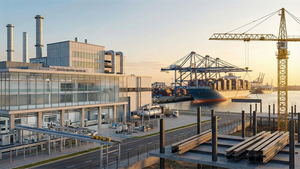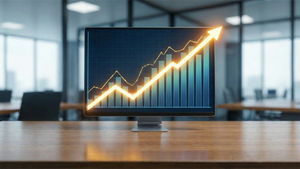
As of late September 2025, the global financial markets are buzzing with the remarkable surge in copper prices, a phenomenon that has seen the industrial metal increasingly dubbed "new gold." This significant upward trajectory, driven by an insatiable demand from the burgeoning green energy sector and persistent supply shortages, is pushing copper towards unprecedented valuation levels. With prices on the London Metal Exchange (LME) settling above $10,180 per ton and futures on the CME trading around $10,640 per tonne, the implications for industries from renewable energy to electric vehicles are immediate and profound, signaling a potential paradigm shift in commodity markets.
Detailed Coverage: The Forces Behind Copper's Meteoric Rise
The current surge in copper prices is a multifaceted phenomenon, primarily propelled by the relentless global push towards decarbonization and a concurrent struggle on the supply side. At the heart of this demand is copper's indispensable role in the energy transition. Electric vehicles (EVs) require three to four times more copper than conventional cars, while renewable energy systems like solar and wind power demand significantly larger quantities per megawatt than fossil fuel alternatives. This structural demand is further amplified by massive government investments in modern energy grids, urban infrastructure, and the exponential growth of energy-intensive AI-driven data centers, each gigawatt of which can consume around 5,500 tonnes of copper.
However, this escalating demand is met by severe and persistent supply constraints. Major mining disruptions, such as the catastrophic mudslide at the Grasberg mine in Indonesia (operated by Freeport-McMoRan (NYSE: FCX)) in September 2025, which led to a significant reduction in global output and a force majeure declaration, have severely impacted supply. Other factors include stricter environmental regulations in key producing nations like Chile and Peru, geopolitical tensions, aging infrastructure, declining ore grades, and prolonged project delays for new mines. These challenges have transformed a previously projected modest surplus into a significant deficit, now expected to range from 300,000 to 500,000 metric tonnes by the end of 2025.
The timeline of copper's ascent in 2025 has been marked by remarkable volatility and consistent upward pressure. After reaching an all-time high of US$5.20 per pound on COMEX in May 2024, prices saw a moderation before a strong rebound in early 2025. By March 2025, New York copper futures hit a historic high of approximately $11,840 per tonne. July 2025 saw another peak at $5.94 USD/Lbs, driven by strong speculative interest. September 2025 has been particularly active, with prices climbing from around $9,500 per metric ton at the start of the month to settle at $10,181.50 per ton on the London Metal Exchange by September 26, culminating in a new high of $10,225 on September 29, before a slight dip. These movements underscore the market's acute sensitivity to both demand signals and supply shocks.
Key players are reacting strategically to this dynamic environment. Major producers like BHP Group (ASX: BHP), Codelco, and Freeport-McMoRan (NYSE: FCX) are accelerating brownfield expansions, increasing exploration budgets, and pursuing technological innovations to improve recovery rates. Codelco and Anglo American (LSE: AAL) even finalized an agreement in September 2025 to merge operations at their Los Bronces and Andina copper mines in Chile, projecting substantial additional production by 2030. On the consumer side, electric vehicle manufacturers and renewable energy companies are implementing forward purchasing, exploring material efficiency, and increasing recycling efforts to secure supply and mitigate rising costs. Speculative traders, as evidenced by significant net long positions, continue to exhibit strong bullish sentiment, further fueling market momentum and volatility.
Copper's comparison to "new gold" stems from its irreplaceable and foundational role in the global energy transition and digital transformation, coupled with its tightening supply. Unlike gold, which is primarily a safe-haven asset, copper's value is derived from its indispensable utility in shaping the future economy. It is the backbone of electrification, powering everything from EVs and renewable energy grids to AI data centers. This structural demand, combined with projected supply deficits of 30-40% below demand by 2035 according to the IEA, makes copper a strategic asset, attracting significant investment and cementing its status as the "metal of the future."
Company Impact: Winners and Losers in the Copper Boom
The sustained ascent of copper prices is creating a clear dichotomy of winners and losers across global industries. At the forefront of the beneficiaries are copper mining companies, poised to reap significant rewards from higher realized prices. Giants like BHP Group (ASX: BHP), with its vast operations including the Escondida mine, and Southern Copper (NYSE: SCCO), holding the world's largest copper reserves, are experiencing direct boosts to their revenues and profit margins. Southern Copper, for instance, aims for 967,000 tons of production in 2025, making it a prime beneficiary. Similarly, Rio Tinto Group (ASX: RIO) is actively developing new copper resources, and Teck Resources (TSX: TECK) projects further production increases, with their stock performance often correlating positively with copper's trajectory. Other major players such as Glencore PLC (LSE: GLEN), Antofagasta (LSE: ANTO), and Anglo American (LSE: AAL) are also seeing their valuations climb, with Anglo American receiving a "Buy" rating from UBS due to its substantial copper exposure. These miners are strategically investing in brownfield expansions, increasing exploration, and pursuing technological innovations to maximize output.
Conversely, industries heavily reliant on copper as a raw material face significant headwinds. Electric vehicle (EV) manufacturers, including Tesla (NASDAQ: TSLA), Lucid Group (NASDAQ: LCID), and Ford (NYSE: F), are particularly vulnerable. EVs require substantially more copper in their motors, wiring, and charging infrastructure, translating directly into increased production costs. This can compress profit margins or necessitate price increases, potentially dampening consumer demand and affecting stock performance. These companies are exploring mitigation strategies such as material substitution, supply chain optimization, and long-term contracts. Nio (NYSE: NIO) and Rivian (NASDAQ: RIVN) may face even greater margin erosion if they lack diversified supply chains or pricing power.
The renewable energy sector, encompassing solar panel manufacturers, wind turbine producers, and grid infrastructure developers, also faces considerable challenges. Companies like First Solar (NASDAQ: FSLR), Enphase Energy (NASDAQ: ENPH), and Canadian Solar (NASDAQ: CSIQ) find that rising copper prices directly inflate the cost of manufacturing and installing copper-intensive components, impacting project viability and potentially slowing the green energy transition. Construction and infrastructure companies, which use copper extensively in electrical wiring and plumbing, similarly face higher project costs, potentially leading to tighter margins or increased bids. Electronics manufacturers producing electric motors and consumer devices also grapple with elevated input costs.
A unique case is Freeport-McMoRan (NYSE: FCX), a major copper miner. While generally benefiting from high copper prices, the catastrophic mudslide at its Grasberg mine in Indonesia in September 2025 led to a force majeure declaration and significant production cuts, causing its shares to decline sharply. This highlights the vulnerability of even large producers to operational shocks, creating a short-term "loser" scenario despite a bullish copper market. Meanwhile, companies involved in copper recycling stand to gain from the higher value of scrap copper, making recycled material a more attractive and sustainable alternative for manufacturers. Additionally, producers of alternative materials, particularly aluminum companies like Hindalco Industries (through its Novelis subsidiary), could benefit if industries increasingly pivot away from copper in certain applications where substitution is feasible.
Wider Significance: A New Supercycle for the 'Metal of the Future'
The sustained surge in copper prices is not merely a transient market fluctuation but rather a profound indicator of broader, structural shifts in the global economy, deeply intertwined with the ongoing energy transition, rapid technological advancements, and the emergence of a new commodity supercycle. Copper's critical role as the "metal of electrification" makes it indispensable for achieving global decarbonization goals. Renewable energy systems, such as solar panels and wind turbines, demand significantly higher quantities of copper—five to ten times more per megawatt—than traditional power generation. The expansion of smart grids, crucial for integrating these intermittent sources, further amplifies this demand.
Beyond green energy, the explosion of electric vehicles (EVs) and artificial intelligence (AI) is creating unprecedented demand. Each EV consumes substantially more copper than its internal combustion counterpart, while AI-optimized data centers, with their higher power densities and extensive cooling requirements, are far more copper-intensive, requiring two to three times more copper per square meter. BHP Group (ASX: BHP) forecasts that AI applications alone could increase global copper demand by an additional 3.4 million tons annually by 2050, highlighting the profound impact of these technological shifts. Many analysts now believe these converging forces are ushering in a new commodities supercycle, distinct from previous cycles, due to its global reach and diverse demand sectors.
The ripple effects of persistently high copper prices are extensive. Industries from electronics and construction to automotive manufacturing face substantially higher input costs, potentially leading to increased consumer prices across a vast array of products and contributing to broader inflationary pressures. Fragile global supply chains are under immense strain, as evidenced by disruptions like the Grasberg mine incident, forcing industries to prioritize strategic planning, diversification, and material efficiency. Critically, delays in copper availability or prohibitively high prices could impede the deployment of vital renewable energy projects and slow the adoption of EVs, jeopardizing national climate goals. Conversely, the escalating demand and supply deficit are spurring significant investment in the copper mining sector and accelerating research into alternative conductive materials and advanced recycling technologies.
Governments and policymakers worldwide are increasingly recognizing copper's strategic importance. It is now widely classified as a "critical mineral," leading to legislative actions like the U.S. Inflation Reduction Act, which facilitates investments in energy grids and EV charging infrastructure, directly boosting copper demand. However, stricter environmental, social, and governance (ESG) regulations in major producing nations, alongside growing resource nationalism, are also contributing to supply constraints through longer permitting processes and increased development costs for new mines. Trade policies also play a role; for instance, former US President Donald Trump's July 2025 announcement of a 50% tariff on copper imports, though refined copper was later exempted, underscored the geopolitical sensitivities surrounding this vital commodity.
Historically, copper prices have served as a reliable barometer for economic health, with surges observed during the 19th-century industrialization, post-WWII reconstruction, and the early 2000s China boom. Similar to these periods, the current surge is demand-driven and contributes to inflationary pressures, exacerbated by inherent long lead times for new mine development and geopolitical influences. However, the current context is unique due to the simultaneous and powerful confluence of decarbonization, electrification, and the explosive growth of AI. This multifaceted demand, coupled with strong policy mandates for net-zero emissions, suggests a potentially more severe and enduring supply-demand imbalance than in previous cycles, with some analysts forecasting a 6 million-tonne shortfall by 2035, posing an unprecedented challenge to global decarbonization efforts.
What Comes Next: Navigating Copper's Bullish Trajectory
The trajectory of copper prices over the next one to five years is poised for continued upward pressure, driven by a persistent and widening supply-demand imbalance, though short-term volatility will remain a defining characteristic. In the immediate 6-12 months, copper prices are expected to maintain strong support above $9,600/mt, bolstered by ongoing supply disruptions—such as the operational vulnerabilities at major mines like Grasberg—and geopolitical risk premiums. Goldman Sachs, for instance, has already revised its 2025 and 2026 copper production growth forecasts downwards due to the Grasberg incident, underscoring the market's sensitivity to supply shocks. Geopolitical tensions and trade policies, including the U.S. government's tariff announcements, will continue to inject uncertainty and influence trade flows, while global economic sentiment, particularly from China, will also play a crucial role.
Looking further out, the long-term outlook for copper is overwhelmingly bullish. Global copper demand is projected to double by 2035, reaching approximately 49 million metric tons, primarily fueled by the "energy transition" (electrification, EVs, renewable energy) and the "digital" sector (data centers, 5G, AI). This unprecedented surge in demand is set against a backdrop of substantial supply constraints. Declining ore grades, aging mines, and extensive lead times (7-15 years) for new mine development make it exceedingly difficult for supply to keep pace. Analysts project a chronic structural supply deficit, potentially reaching 9.9 MMt by 2035 in a "Rocky Road Scenario," which is expected to propel copper prices to new all-time highs, with some forecasts exceeding $10,000/ton by 2028 and potentially reaching $6.15-$6.50/lb by 2027.
To navigate this evolving landscape, strategic pivots are imperative for all key stakeholders. Miners must significantly increase investment in new projects and exploration, estimated at $250 billion by 2030, while embracing technological advancements to improve recovery rates from lower-grade deposits. ESG pressures and the need for sustainable practices will also drive consolidation and partnerships, such as the proposed "Anglo Teck" merger, to achieve economies of scale and diversified assets. Manufacturers, on the other hand, must prioritize supply chain resilience, explore material substitution (e.g., aluminum in some electrical applications), innovate to reduce copper intensity, and invest heavily in recycling infrastructure, as secondary copper supply is projected to provide up to 35% of global supply by 2030.
Governments will play a critical role through policy. They must balance resource nationalism with the need for increased mineral extraction, streamline permitting processes, offer investment incentives for domestic mining and refining, and foster international cooperation to diversify supply chains. Emerging markets, particularly outside China, present significant opportunities, as they are expected to drive over 60% of global copper demand growth by 2025 due to rapid urbanization and infrastructure development. These nations also have the chance to move beyond raw material exports by investing in local processing and refining.
Potential scenarios for the copper market over the next 1-5 years include a Bullish Scenario, where robust demand far outstrips constrained supply, leading to surging prices and new all-time highs, albeit with higher costs for green technologies. A Bearish Scenario could emerge from a severe global economic recession, significantly dampening demand and leading to price declines and a temporary surplus. The Base Case Scenario anticipates gradual price appreciation with persistent volatility, driven by a steady increase in demand and moderate supply growth, with the deficit reflecting in pricing after 2025. Factors that could significantly alter this trajectory include technological breakthroughs in material substitution, dramatic shifts in global climate policies, geopolitical instability leading to supply chain disruptions, major economic shocks, and the efficacy of copper recycling efforts.
Wrap-up: Copper's Enduring Legacy and Investor Outlook
The global copper market is undergoing a profound structural transformation, transitioning from cyclical price movements to a sustained, demand-driven bullish trend. The key takeaways from the current surge are clear: copper's indispensable role in the energy transition, the explosive growth of AI and EVs, and persistent supply constraints have firmly established its status as "new gold." This vital industrial metal is not merely a commodity; it is a strategic cornerstone for the future electrified and digital economy.
Moving forward, the copper market is expected to remain exceptionally tight, with widening deficits projected beyond 2025. This scarcity poses a significant challenge to the ambitious goals of global decarbonization, potentially increasing the cost and slowing the pace of the transition to a low-carbon economy. The lasting impact will be felt across all copper-intensive industries, forcing innovation in material usage, accelerating recycling efforts, and reshaping global supply chains. Furthermore, the rise of resource nationalism and the increasing focus on critical minerals will continue to influence trade policies and investment decisions worldwide.
For investors, vigilance will be paramount in the coming months and years. Key indicators to watch include mining production reports from major players like BHP Group (ASX: BHP), Southern Copper (NYSE: SCCO), and Freeport-McMoRan (NYSE: FCX), particularly updates on operations at disrupted mines and the progress of new projects. Declining exchange inventory levels and low treatment and refining charges will signal continued market tightness. On the demand side, monitoring global economic data, EV sales figures, and the pace of renewable energy installations, especially from major consumers like China, will be crucial. Macroeconomic factors such as US dollar strength and interest rate movements will also influence prices. Finally, technological advancements in recycling and potential material substitution, alongside evolving government policies on critical minerals and trade tariffs, could significantly alter copper's long-term trajectory. Understanding these dynamics will be essential for navigating the opportunities and risks presented by copper's pivotal role in the global economy.
This content is intended for informational purposes only and is not financial advice

















